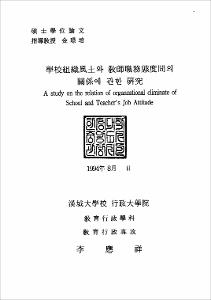學校組織風土와 敎師職務態度間의 關係에 관한 硏究
- Files in This Item:
-
-
Download
 000000066334.pdf
기타 데이터 / 1.53 MB / Adobe PDF
000000066334.pdf
기타 데이터 / 1.53 MB / Adobe PDF
-
Items in Repository are protected by copyright, with all rights reserved, unless otherwise indicated.
 000000066334.pdf
기타 데이터 / 1.53 MB / Adobe PDF
000000066334.pdf
기타 데이터 / 1.53 MB / Adobe PDFItems in Repository are protected by copyright, with all rights reserved, unless otherwise indicated.